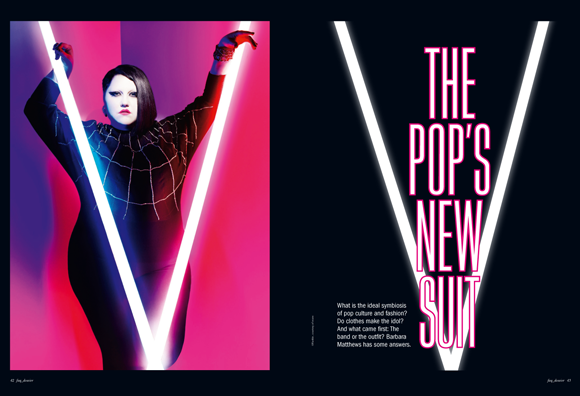I had spent weeks fantasizing about it, and there it was. A bow-tie made out of blonde hair, resembling the elaborate construct Lady Gaga wore on her head in recent months. With a fervor usually reserved for die-hard fans, I snatched up the accessory and proudly wore it perched on my head on my next outing. What would possess someone like me, who strays far, far away from pop fandom and couldn’t sing half a Lady Gaga chorus if my life depended on it, (okay, fine, „ppp-okerface“!) to suddenly want to imitate her? Is subliminal marketing to blame, or something else?
Sure, clever marketing has made people do strange things before – like buy Lady Gaga albums in the first place. But since the dawn of pop culture, two things have been inseperable: music and fashion. And for just about as long, the ultimate question has been, „what came first, the band or the outfit?“ Music has always been the media of the street, and has always brought the street to the media. But the line between starting a trend and selling a brand has been blurred. With waning album sales figures and barely sustainable tours, musicians are learning that a sidestep towards fashion is almost inevitable. And I’m not talking merchandise here – although, the Hannah Montana/Jonas Brothers phenomenon that has swept through the US certainly isn’t to be ignored. No, the musician of today tries his or her hand at something else: their own fashion line.
The Punk of Fashion – the Fashion of Punk
It all began with Vivienne Westwood, who under the watchful eye of her business partner Malcom McLaren, screenprinted a safety pin through the Queen’s visage and slapped it on a t-shirt. Ever the marketing man, McLaren made his ultimate punk-rock boy band sport the outfits and start a worldwide trend. The Sex Pistols became the touring models for the designs that decorated the Westwood/McLaren boutique „SEX“. And as the Sex Pistols gained notorierty with their no-future-battle cries, their on-stage clothing became the uniforms of disenchanted teenagers the world over. „SEX“ sold clothing inspired by fetishism and BDSM that was further transformed by adding chains or Marxist slogans on stencils. The clothing was the perfect illustration of the aggression found in punk rock’s lyrics and three-chord songs. It was ugly, garish, uncomfortable and incessantly provocative. When the middle finger failed to suffice, it was Johnny Rotten’s hair that was replicated, hundreds of stick straight strands of hair combed uptowards the sky and against authority.
Even before the late 70s, clothing had a soundtrack. One needs to only think of the bellbottoms at Woodstock or the Quadrophenia mods clamoring for their Fred Perry. One can’t imagine music without an image – even those well intentioned souls who claim that, to them, it doesn’t matter what their favourite singer looks like, have to admit that pop music relies as heavily on what you see as what you hear. It can be taken over the top, but even before stylists come in and board meetings decide photoshoot fashion, a musician coneys some allegiance through his or her clothes. Just take a look at some press images without listening to the bands and I am sure you can guess what kind of music those bands make.
Punk though was perhaps the first movement where the clothing surpassed the music and managed to carve out a niche for itself far beyond its original intentions. What was spawned with parachute pants and suspenders in London became Gwen Stefani and No Doubt’s outfit of choice in the 90s – all the way from the UK to Southern California. The funny thing about punk is that despite its repeated attempts to commercialize the thing, to place it out of context (Avril Lavigne’s fashion line comes to mind), it remains as powerful and disconcerting today as it did thirty years ago. There is no sweet nostalgia associated with it and it is also the only music-inspired fashion trend that lives on in a very prominent subculture today. The music was based on something emphemeral, something that can’t be replicated by someone over 30. But the clothing continues to be accessible to all rebelious age groups. I’d rather see someone 50+ sporting plaid pants than trying to put teenage rage on an album – I’m looking at you, Johnny Rotten. Gutter punks with their ratty clothes, crazy hair and interesting interpretations of hygiene, from the streets of Portland to Brooklyn will remind you that punk’s not dead, even if they don’t own a Sex Pistols record.
It took until the mid-90s for entrepreneurial musicians to pick up on the whole clothing line thing again. It is a mystery as to why Madonna did not capitalize on her iconic status and avant garde fashion choices before her 2006 collection for cheapie fashion brand H&M. Sonic Youth’s Kim Gordon (X-Girl) and sort-of rockstar Sofia Coppola (Milkfed) tried their hands at indie, grungy clothing, but both never really launched a line with bravado. Both chose to focus on international markets, so perhaps it is not up to me to judge how well Coppola’s clothing does in Japan, where it continues to be sold. In the 90s, musicians were the muses of fashion designers, and in the high-time of the super model it wasn’t a popstar’s job to sit at the drafting table. They were the ones on the runway, they were the ones who lines were created for. That of course did not apply to the burgeoning hip hop scene.
From Run DMC to P.Diddy
Hip hop has always been a world of hustlers and a quick buck. Throughout the growth of the genre, from the streets to the television screen, brand names always played a big role. One only needs to think of Run DMC’s „My Adidas“ and its subsequent sponsorship deal for the group. It was the work of one man though, that turned hip hop and fashion on ist head. In 1998, Sean „Puffy“ Combs launched his own mega million men’s fashion brand Sean John. The sportswear brand has expanded to the runway, eyewear and fragrance. Sean Combs was one of the first artists who managed to replicate the success he had with his musical empire Bad Boy in the fashion world.
Sean Combs is not a designer though, he is an entrepreneur. Sean John is a multimillion dollar company that he heads, but one cannot imagine him sweating late nights over the drawing table, creating the latest designs. Rather, he is the emperor who gets to pick his new clothes as his assistants flounder about him, trying to impress him with their work. Although on his website he claims he wanted to „fill a void in the market“, Sean John did not revolutionize fashion in the artistic sense. The clothing is sleek as well as sporty, but it is nothing we hadn’t seen before.
What men got were oversized white t-shirts, enormously baggy pants, and, at the higher end, suits they didn’t really have an occasion to wear. Suddenly, every male was either a baller or a bilionaire – at least to me, that missed a major chunk of the demographic. And of course, the question remains – where are the sartorial ladies of hip hop? It wasn’t until this decade that Missy Elliott signed on to design for Adidas and Nelly decided to make Apple Bottom Jeans. But I don’t remember ever noticing celebrity streetwear for girls. Ironic, somehow. In the 90s, the fashion war between the camps was a man’s game.
The important thing about Sean John was and is the logo, which served as advertising for Bad Boy and all its affiliates. Sean John the clothing line is the culmination of everything mainstream hip hop has strived for and continues to uphold an elegance based solely on the image perpetuated by its creator. In short, it’s nothing special but so many people have been convinced that everything P. Diddy touches turns to gold, that the brand manages to sustain itself on that alone. Does anyone remember when P. Diddy’s last record came out? Exactly.
It has become part of the machinery of making a popstar to include the option of a clothing line. It is what Gwen Stefani did with L.A.M.B., a clothing line that came and went and tried desperately to latch onto the garish Harajuku girl trend Ms. Stefani westernized in her music video. Beyonce name-drops her mother’s venture „Dereon Jeans“ in her smash „Single Ladies“ and poses for its print advertisements. But these are merely faces used to move product.
Liam Gallagher and Beth Ditto: A Great Deal in Common
There has been, as of late, a resurgence of musicians getting their hands dirty in the game though. Just this year, two very well-known and very different artists launched high profile fashion lines. Liam Gallagher, of Oasis fame, launched Pretty Green, a fashion venture named after a Clash song. „Pretty Green is an up-front, straight talking, classic clothing range“, touts the website and one wonders why the world needs another basic jeans and t-shirt shop. „Clothes and music are my passion“, claims Gallagher further and I am forced to think back on the past decade with Oasis in the spotlight. Has Liam Gallagher ever worn anything but that ubiquitous green parka? The answer is no, and that is exactly what Mr. Gallagher wants to sell with Pretty Green. Polos, parkas and hats can be had in the 55GBP range. Aside from the psychedelic logo, the designs and colours could also have been supplied by mod-master Fred Perry.
The charming thing about Pretty Green is that it is obviously Liam Gallagher’s newest baby, made clear by the promotional videos showing him talking up the line and his own modeling for the website. Regardless of his actual involvement in the creative process, he is apparently very hands-on in all aspects of the company. And yet, the cynic in me looks at his offerings and scoffs: this is so ten years ago! Had Mr. Gallagher started Pretty Green at the height of his career on the Britpop wave, it would have catapulted him to P. Diddy’s status, I am certain of it. But now it seems tired and unecessary, the last sputtering out of the Oasis camp. Too little, too late. My predicition is that Pretty Green will disappear into the void as quickly as it came out of it.
The other musician who jumped into the shark tank of fashion this year seemed equally unlikely to ever make a mark in this business. Beth Ditto is the oversized frontwoman of the indie-punk-band-cum-worldwide-pop-sensation The Gossip. Over the past few years, Beth Ditto has been unapologetic about her appearance and turned the fashion world on its head. Befriending both Karl Lagerfeld and Kate Moss in one fell swoop, she has taken the front rows at fashion weeks all over the world by storm and has stretched the boundaries of what a „fat“ girl can do. Her thriftstore chic combined with designer pieces have made her an icon to glitzy gays and struggling teenagers the world over. Everything she wears is a statment and it is wonderfully refreshing to see how someone at a seeming disadvantage can have so much fun with fashion.
When rumours emerged that British chain Topshop was courting Ms. Ditto for a clothing line, she responded on a blog: „I don’t think it’s fair to put my face somewhere where they would never let me in there to wear their clothes.“ Parent company Arcadia took note and offered Ms. Ditto the chance to design a line for plus-sized retailer Evans. The first images from the collection were modelled by a girl far skinnier than Ditto, causing an uproar online. If Ms. Ditto was in charge here, how come her fashion line was making concessions and yet again catering to „the man“?
In the meantime, Beth Ditto has become the spokesmodel of her own line. The clothing though is lackluster and even though sales figures for the first month are not available online, they seemed to have fallen below expectations. The only item currently sold out on the website is a belt, which, says the biting tongue, was probably bought up by thinner ladies. Whereas the Pretty Green line is almost too much Gallagher, Beth Ditto for Evans does not seem to reflect the singer’s stage glam at all. The colours are drab, the details are missing and overall, this is nothing special. Sure, Beth Ditto for Evans was meant to expand the clothing choices for the young plus sized woman, but, let’s be honest: We were all, regardless of size, excited to snap up some of the golden glitter lamee leggings we’ve seen the singer rock on the red carpet, or anything multi-coloured and sparkly that’s she’s made her trademark. A plain black dress or a t-shirt with cat’s face on it weren’t what I had in mind.
From individuality to mass consumption
So what is the ideal symbiosis of music and fashion? The inevtiable one is, of course, that the audience will always imitate the star. The first few rows at a concert of any given band will always be a mirror. But how far can that organic phenomenon be taken? Should rockstars dress their fans? Maybe the recent rediscovery of the musician as the muse should be the way of the future. Lily Allen’s tongue-in-cheek charm inspired Karl Lagerfeld to create a line of handbags, she became the campaign’s face because, according to him, „she’s fun“. Similiarily, a few years back, he recruited blues queen Cat Power to perform live at the end of the catwalk for a Chanel show in Paris. Diane von Furstenberg handpicked the Kills new album as the soundtrack to one of her recent shows. And we’ll just have to wait and see that they do with the newest pet of pop, La Roux.
When an actor tries to make music, or when a singer tries to act, the press pounces on it and proclaims that artists should stick to what they’re good at, instead of jumping across professions. The same thing could be said for music and fashion – let the two run side by side, let them be complementary and inspiring, but let’s not get too caught up in it. One discipline always suffers, and at the end of the day, it is more important to me that the Gossip make another spectacular album, than to own a frumpy dress with a fancy tag sown in. It is more exciting to me to see what the fans come up with inspired by their idols on stage, rather than what the celebrities will sell to their fans. Musicians‘ clothing lines are merely a way to turn their individuality into mass consumption. That’s why I continue to wear my Lady Gaga hairpiece with pride, and I won’t retire it until she sells her own on her website.


